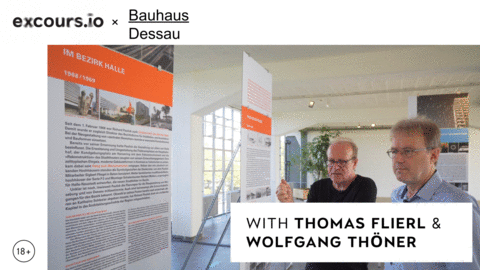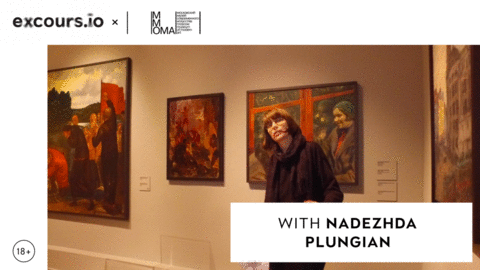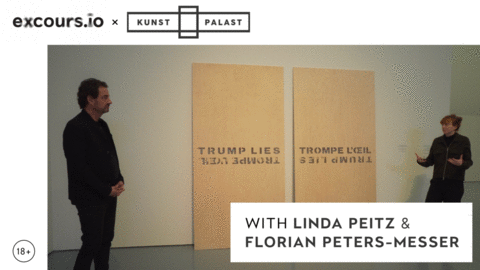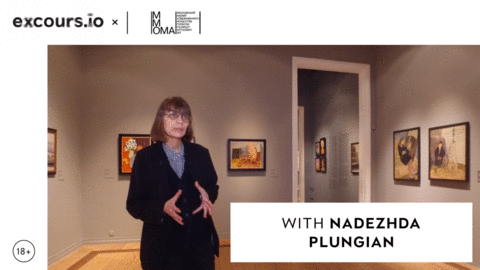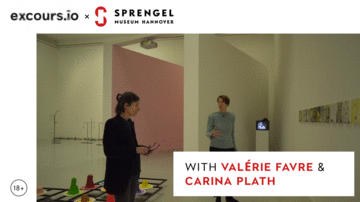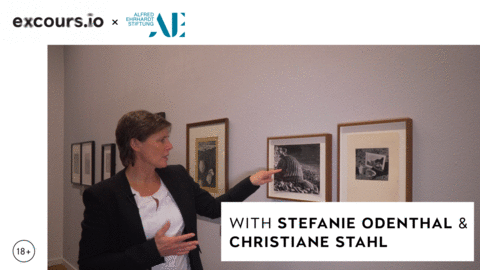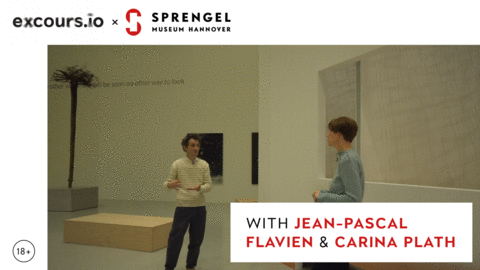Bauhaus – Shanghai – Stalinallee – Ha-Neu. The life of architect Richard Paulick, 1903–1979
Why should you watch this?
Implicit Modernism. Roman Babichev’s Collection. Part I.
Why should you watch this?
TIME FOR OUTRAGE! Art in Times of Social Anger | Trumpism
Can anger and rage be justified in a world riddled with oppression and inequality? Are these emotions destructive forces or vital catalysts for social change? As democracy faces crises and populism gains ground globally, these questions have sparked renewed debate. Contemporary artists have responded, using their work to navigate and challenge the pressing issues of our time.
The exhibition ‘Time for Outrage!’ in Düsseldorf explores these questions through six thematic blocks: Right-wing Shift, Trumpism, Protest, Postcolonialism, Feminism, and Discrimination. Across a diverse range of mediums — including installations, drawings, paintings, sculptures, photography, and video art — 40 international artists immerse viewers in the visceral realms of protest, social dissent, and public anger. The exhibition doesn’t just present anger as a raw emotion; it portrays it as a vehicle for dialogue, resistance, and empowerment in the face of systemic injustice.
A substantial portion of the works on display come from the collection of entrepreneur and collector Florian Peters-Messer, whose commitment to socially engaged art amplifies the urgent messages these pieces convey.
Why should you watch this?
Only by faith! On the occasion of the 500th Anniversary of the Reformation
Unveiling the transformative journey of Protestantism, this exhibition showcases around 150 artifacts from the State Museum of the History of Religion, bringing to life the pivotal moments and influential figures, such as Martin Luther, that shaped this movement. Spanning from the 16th century to the present, it delves into the synergy between religion and culture, revealing how Protestant ideals influenced art, literature, and social change. This rich array of historical items not only contextualizes the theological underpinnings of the Reformation but also illustrates its enduring legacy in contemporary society. It is an enlightening exploration that challenges the boundaries between faith and creativity, inviting visitors to reflect on the profound impact of Protestantism on our world today.
Why should you watch this?
In today’s context, this exhibition on Protestantism serves as a crucial reflection on the enduring influence of religion in shaping contemporary values, culture, and identity. As society navigates complex discussions around faith, freedom of expression, and social justice, the historical insights revealed through artifacts and narratives from the Protestant Reformation prompt us to consider how these early movements laid the groundwork for modern thought and civil rights. By revisiting the struggles and triumphs of figures like Martin Luther, we gain a deeper understanding of the ideological battles that resonate in current debates about religious tolerance, individualism, and community life. This exploration invites us to connect the past to the present, encouraging critical dialogue on the role of faith in our increasingly pluralistic world.
HOW TO SURVIVE ― Art as Survival Strategy | with Paula Schwerdtfeger
The group exhibition presents a compelling exploration of how art provides resilience in times of personal and societal crisis. The exhibition features works by renowned artists like Gustav Metzger, Shusaku Arakawa, and Alina Szapocznikow, each of whom faced extreme adversity and transformed their experiences into profound artistic statements. Whether addressing environmental destruction, illness, or existential threats, these artists used creativity as a means to survive and challenge the limits of human endurance. The exhibition emphasizes the power of art to propose alternative perspectives when the world seems trapped in binary thinking. By engaging with radical artistic responses to crisis, visitors are invited to reflect on how creativity can offer strength, hope, and new possibilities for navigating the uncertainties of modern life. Art, in this context, becomes more than expression — it becomes a strategy for survival and transformation.
Why should you watch this?
The exhibition tackles pressing issues like climate change, personal trauma, and social upheaval, and having a knowledgeable guide helps to bring those themes to life. It’s not just about admiring the art; it’s about understanding the stories and survival strategies that inspired each piece. This context makes the art resonate even more, helping you connect with the messages in a meaningful way. In a time when we’re all looking for ways to navigate challenges, a guided tour offers fresh insights that can spark reflection and inspire hope.
Implicit Modernism. Roman Babichev’s Collection. Part II.
The exhibition presents Roman Babichev’s collection as a compelling exploration of Soviet modernism, challenged by decades of controversy surrounding the term due to the anti-formalist campaigns of the 1930s and Cold War ideological battles. Offering a fresh lens, the exhibition sheds light on the often-overlooked variety within Soviet art, breaking down entrenched stereotypes and revealing the interconnections among post-avant-garde communities active after the 1932 ban on creative associations. By emphasizing the nuanced expressions of these artists—whose declarations were rendered in their unique painting styles rather than explicit statements—the exhibition invites viewers to reassess the rich tapestry of Soviet artistic heritage through a symbolist perspective, encouraging a more multidimensional understanding of its evolving narrative.
Why should you watch this?
The exhibition challenges prevailing narratives about art and encourages critical engagement with the complexities of cultural identity. In a time when discussions about artistic censorship, identity politics, and the role of art in society are more pertinent than ever, this exhibition provides a vital platform to explore how historical legacies shape contemporary artistic expressions. By delving into the often-misunderstood facets of Soviet modernism, viewers will uncover important parallels with current global movements calling for the recognition of marginalized voices and the reevaluation of entrenched ideologies. The guided experience not only enriches understanding of the artwork but also fosters a dialogue about the role of art as a form of resistance and expression in addressing modern societal challenges.
HOW TO SURVIVE ― Art as Survival Strategy | with Valérie Favre & Carina Plath
The group exhibition presents a compelling exploration of how art provides resilience in times of personal and societal crisis. The exhibition features works by renowned artists like Gustav Metzger, Shusaku Arakawa, and Alina Szapocznikow, each of whom faced extreme adversity and transformed their experiences into profound artistic statements. Whether addressing environmental destruction, illness, or existential threats, these artists used creativity as a means to survive and challenge the limits of human endurance. The exhibition emphasizes the power of art to propose alternative perspectives when the world seems trapped in binary thinking. By engaging with radical artistic responses to crisis, visitors are invited to reflect on how creativity can offer strength, hope, and new possibilities for navigating the uncertainties of modern life. Art, in this context, becomes more than expression — it becomes a strategy for survival and transformation.
Why should you watch this?
The exhibition tackles pressing issues like climate change, personal trauma, and social upheaval, and having a knowledgeable guide helps to bring those themes to life. It’s not just about admiring the art; it’s about understanding the stories and survival strategies that inspired each piece. This context makes the art resonate even more, helping you connect with the messages in a meaningful way. In a time when we’re all looking for ways to navigate challenges, a guided tour offers fresh insights that can spark reflection and inspire hope.
Nautilus – Snails, Shells, and Mollusks in Photography
The exhibition delves deep into the captivating world of shells and snails as seen through the lenses of iconic modern photographers like Edward Weston and Imogen Cunningham. This pioneering showcase assembles a rich tapestry of images, tracing humanity’s longstanding fascination with these natural forms—from their mathematical elegance to their cosmic symbolism. Grounded in Alfred Ehrhardt’s seminal works, including his influential books “Muscheln und Schnecken” and “Geprägte Form,” the exhibition also highlights the intersection of art and science, featuring innovative techniques like X-ray photography and the New Objectivity movement. Beyond mere visual appeal, the show offers an exploration of cultural significance, inviting viewers to reflect on the beauty and complexity of these “structural forms in nature,” culminating in the screening of Ehrhardt’s award-winning film “Tanz der Muscheln.”
Why should you watch this?
The exhibition at the Alfred Ehrhardt Foundation serves as a timely reminder of the profound connection between art, nature, and cultural history, inviting contemporary audiences to reflect on our relationship with the natural world. In an era increasingly defined by technology and rapid change, this exploration of shells and snails highlights the enduring allure of organic forms, encouraging a return to appreciation for the intricate beauty found in nature. By showcasing how modern photographers have captured these motifs—often imbued with deep symbolic significance—the exhibition underscores the relevance of natural elements in contemporary art and design, prompting discussions about sustainability and the need for mindful engagement with our environment. Furthermore, the intersection of art and science represented in this collection resonates with current dialogues on ecological awareness, reminding us that aesthetic appreciation can foster a deeper understanding of the world we inhabit.
HOW TO SURVIVE ― Art as Survival Strategy | with Jean-Pascal Flavien & Carina Plath
The group exhibition presents a compelling exploration of how art provides resilience in times of personal and societal crisis. The exhibition features works by renowned artists like Gustav Metzger, Shusaku Arakawa, and Alina Szapocznikow, each of whom faced extreme adversity and transformed their experiences into profound artistic statements. Whether addressing environmental destruction, illness, or existential threats, these artists used creativity as a means to survive and challenge the limits of human endurance. The exhibition emphasizes the power of art to propose alternative perspectives when the world seems trapped in binary thinking. By engaging with radical artistic responses to crisis, visitors are invited to reflect on how creativity can offer strength, hope, and new possibilities for navigating the uncertainties of modern life. Art, in this context, becomes more than expression — it becomes a strategy for survival and transformation.
Why should you watch this?
The exhibition tackles pressing issues like climate change, personal trauma, and social upheaval, and having a knowledgeable guide helps to bring those themes to life. It’s not just about admiring the art; it’s about understanding the stories and survival strategies that inspired each piece. This context makes the art resonate even more, helping you connect with the messages in a meaningful way. In a time when we’re all looking for ways to navigate challenges, a guided tour offers fresh insights that can spark reflection and inspire hope.

